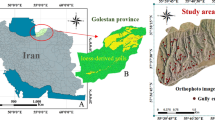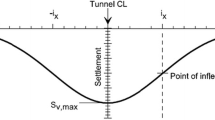Abstract
Ground loss is the volume of soil excavated in excess of designed excavation. It defines the boundary conditions for ground deformation field and thereby dominates the magnitude of tunneling-induced ground settlement. In practice, it is generally quantified by a parameter called ground loss parameter. To date, there is no unanimously agreed formulation for ground loss parameter despite its indispensable role in developing both empirical and analytical solutions for tunneling-induced ground settlement. Herein, a comprehensive field database is utilized to quantitatively assess existing formulations of ground loss, and to unravel its role in settlement prediction via inverse analysis. It reveals that remarkable errors can be generated by classical solutions for tunneling-induced ground settlement. This implies that the reliability of classical solutions for tunneling-induced settlement can be potentially improved with a more accurate formulation of ground loss. A data-driven formulation for ground loss is developed with aid of the random forest algorithm, and it can well capture the target value with an R-value equaling 0.84. The developed formulation is further implemented in the O’Reilly and New solution, yielding a hybrid model for settlement prediction. The hybrid model can accurately predict the actual settlement with an R-value of 0.84, outperforming the purely data-driven model and further confirming the accuracy of the proposed formulation of ground loss.











Similar content being viewed by others
Data availability
The datasets generated during and/or analyzed during the current study are available from the corresponding author on reasonable request.
References
Allen DM (1974) The relationship between variable selection and data agumentation and a method for prediction. Technometrics 16(1):125–127
Atkinson JH, Potts DM (1977) Subsidence above shallow tunnels in soft ground. J Geotech Eng 103(4):307–325
Attewell P, Farmer I (1974) Ground deformations resulting from shield tunnelling in London Clay. Can Geotech J 11(3):380–395
Breiman L (2001) Random forests. Mach Learn 45(1):5–32
Bobet A (2001) Analytical solutions for shallow tunnels in saturated ground. J Eng Mech 127(12):1258–1266
Chakeri H, Ozcelik Y, Unver B (2013) Effects of important factors on surface settlement prediction for metro tunnel excavated by EPB. Tunn Undergr Space Technol 36:14–23
Chambon P, Corte JF (1994) Shallow tunnels in cohesionless soil: stability of tunnel face. J Geotech Eng 120(7):1148–1165
Chen R, Tang L, Yin X, Chen Y, Bian X (2015) An improved 3D wedge-prism model for the face stability analysis of the shield tunnel in cohesionless soils. Acta Geotech 10(5):683–692
Chi S-Y, Chern JC, Lin CC (2001) Optimized back-analysis for tunneling-induced ground movement using equivalent ground loss model. Tunn Undergr Space Technol 16(3):159–165
Chou WI, Bobet A (2002) Predictions of ground deformations in shallow tunnels in clay. Tunn Undergr Space Technol 17(1):3–19
Clough GW, Schmidt B (1981) Design and performance of excavations and tunnels in soft clay. In: Brand EW, Brenner RP (eds) Soft clay engineering. Elsevier, Amsterdam
Dalong J, Xiang S, Dajun Y (2020) Theoretical analysis of three-dimensional ground displacements induced by shield tunneling. Appl Math Model 79:85–105
Fattah MY, Shlash KT, Salim NM (2013) Prediction of settlement trough induced by tunneling in cohesive ground. Acta Geotech 8(2):167–179
Fu J, Yang J, Klapperich H, Wang S (2016) Analytical prediction of ground movements due to a nonuniform deforming tunnel. Int J Geomech 16(4):04015089
Glossop N (1978) Ground movements caused by tunnelling in soft soils. Dissertation, University of Durham
Golpasand MRB, Nikudel MR, Uromeihy A (2016) Specifying the real value of volume loss (VL) and its effect on ground settlement due to excavation of Abuzar tunnel, Tehran. Bull Eng Geol Env 75(2):485–501
Gonzalez C, Sagaseta C (2001) Patterns of soil deformations around tunnels. Application to the extension of Madrid Metro. Comput Geotech 28(6–7):445–468
Jin H, Yuan D, Jin D, Wu J, Wang X, Han B, Mao J (2022) Shield kinematics and its influence on ground settlement in ultra-soft soil: a case study in Suzhou. Can Geotech J 59(11):1887–1900
Kannangara KPM, Zhou W, Ding Z, Hong Z (2022) Investigation of feature contribution to shield tunneling-induced settlement using Shapley additive explanations method. J Rock Mech Geotech Eng 14(4):1052–1063
Knothe S (1957) Observations of surface movements under influence of mining and their theoretical interpretation. In: Proceedings of the European Congress on Ground Movement, pp 210–218
Lee K, Rowe RK, Lo K (1992) Subsidence owing to tunnelling. I. Estimating the gap parameter. Can Geotech J 29(6):929–940
Lin Q, Tian Y, Lu D, Gong Q, Du X, Gao Z (2021) A prediction method of ground volume loss variation with depth induced by tunnel excavation. Acta Geotech 16(11):3689–3707
Loganathan N, Poulos H (1998) Analytical prediction for tunneling-induced ground movements in clays. J Geotech Geoenviron Eng 124(9):846–856
Loganathan N, Poulos H, Stewart D (2000) Centrifuge model testing of tunnelling-induced ground and pile deformations. Géotechnique 50(3):283–294
Ma C, Lu D, Du X, Qi C (2018) Effect of buried depth on seismic response of rectangular underground structures considering the influence of ground loss. Soil Dyn Earthq Eng 106:278–297
Mitchell T (1997) Machine learning. McGraw-hill, New York
O'Reilly MP, New B (1982) Settlements above tunnels in the United Kingdom-their magnitude and prediction. Tunneling 171–193
Park KH (2005) Analytical solution for tunnelling-induced ground movement in clays. Tunn Undergr Space Technol 20(3):249–261
Park K (2004) Elastic solution for tunneling-induced ground movements in clays. Int J Geomech 4(4):310–318
Peck RB (1969) Deep excavations and tunneling in soft ground In: Proceedings of the international conference in soil mechanics and foundation engineering, pp 225–290
Peila D (1994) A theoretical study of reinforcement influence on the stability of a tunnel face. Geotech Geol Eng 12(3):145–168
Ren DJ, Shen SL, Arulrajah A, Wu HN (2018) Evaluation of ground loss ratio with moving trajectories induced in double-O-tube (DOT) tunnelling. Can Geotech J 55(6):894–902
Rowe R, Lo K, Kack G (1983) A method of estimating surface settlement above tunnels constructed in soft ground. Can Geotech J 20(1):11–22
Rowe RK, Lee K (1992) Subsidence owing to tunnelling. II. Evaluation of a prediction technique. Can Geotech J 29(6):941–954
Sagaseta C (1987) Analysis of undrained soil deformation due to ground loss. Géotechnique 37(3):301–320
Sugimoto M, Sramoon A (2002) Theoretical model of shield behavior during excavation. I: theory. J Geotech Geoenviron Eng 128(2):138–155
Suwansawat S, Einstein HH (2006) Artificial neural networks for predicting the maximum surface settlement caused by EPB shield tunneling. Tunn Undergr Space Technol 21(2):133–150
Tang L, Na S (2021) Comparison of machine learning methods for ground settlement prediction with different tunneling datasets. J Rock Mech Geotech Eng 13(6):1274–1289
Verruijt A (1998) Deformations of an elastic half plane with a circular cavity. Int J Solids Struct 35(21):2795–2804
Vu MN, Broere W, Bosch J (2016) Volume loss in shallow tunnelling. Tunn Undergr Space Technol 59:77–90
Wang C, Wang K, Tang D, Hu B, Kelata Y (2022) Spatial random fields-based Bayesian method for calibrating geotechnical parameters with ground surface settlements induced by shield tunneling. Acta Geotech 17(4):1503–1519
Ying H, Cheng K, Liu S, Xu R, Lin C, Zhu C, Gan X (2022) An efficient method for evaluating the ground surface settlement of Hangzhou metro deep basement considering the excavation process. Acta Geotech 17(11):5759–5771
Zhang K, Lyu HM, Shen SL, Zhou A, Yin ZY (2020) Evolutionary hybrid neural network approach to predict shield tunneling-induced ground settlements. Tunn Undergr Space Technol 106:103594
Zhang P, Yin ZY, Chen RP (2020) Analytical and semi-analytical solutions for describing tunneling-induced transverse and longitudinal settlement troughs. Int J Geomech 20(8):04020126
Zheng G, Dai X, Diao Y, Zeng CF (2016) Experimental and simplified model study of the development of ground settlement under hazards induced by loss of groundwater and sand. Nat Hazards 82(3):1869–1893
Zhu C, Li N (2017) Prediction and analysis of surface settlement due to shield tunneling for Xi’an Metro. Can Geotech J 54(4):529–546
Acknowledgements
This research was sponsored by the National Key Research and Development Program of China (2019YFB1705201) and National Natural Science Foundation of China (Grants No. 52090082). These financial supports are gratefully acknowledged. We sincerely appreciate the thoughtful and constructive comments provided by the editor and reviewers.
Author information
Authors and Affiliations
Corresponding author
Additional information
Publisher's Note
Springer Nature remains neutral with regard to jurisdictional claims in published maps and institutional affiliations.
Rights and permissions
Springer Nature or its licensor (e.g. a society or other partner) holds exclusive rights to this article under a publishing agreement with the author(s) or other rightsholder(s); author self-archiving of the accepted manuscript version of this article is solely governed by the terms of such publishing agreement and applicable law.
About this article
Cite this article
Ren, Y., Zhang, C., Zhu, M. et al. Significance and formulation of ground loss in tunneling-induced settlement prediction: a data-driven study. Acta Geotech. 18, 4941–4956 (2023). https://doi.org/10.1007/s11440-023-01859-8
Received:
Accepted:
Published:
Issue Date:
DOI: https://doi.org/10.1007/s11440-023-01859-8




